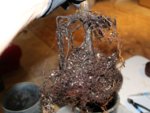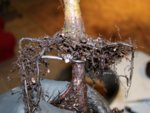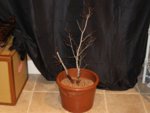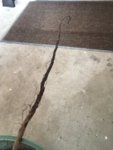I ordered some European beech seedlings online and they came yesterday. They were about 20-30" long and all had a root system as pictured. I had told the nursery that I was using them for bonsai. Maybe they don't understand what that means. My fault for not asking them if they were container grown or grown in the ground I guess. The tap roots were about 6-10" long with very few feeder roots. Any suggestions as to what to do with them? Thanks for help!
You are using an out of date browser. It may not display this or other websites correctly.
You should upgrade or use an alternative browser.
You should upgrade or use an alternative browser.
Beech seedlings
- Thread starter August44
- Start date
Orion_metalhead
Masterpiece
I would chop the tap root so as to leave yourself a handful of decent feeder roots along the rest of the root and progressively cut the tap root further back at each repot as you get better feeder roots up the trunk to the point where you want your nebari to start.
Orion_metalhead
Masterpiece
"Handful" was a figure of speech.
Just leave yourself several decent feeder roots above your cut point. You should get root growth back off those roots and elsewhere and be able to cut back further as you progressively repot the seedlings every year or two.
Just leave yourself several decent feeder roots above your cut point. You should get root growth back off those roots and elsewhere and be able to cut back further as you progressively repot the seedlings every year or two.
Wires_Guy_wires
Imperial Masterpiece
I would plant these out, see whatever survives and stick with Orion_metalheads plan, but after at least a year of recovery.
Nurseries understand what bonsai is, just not how it's done. And I don't blame them; the costs/benefits on bonsai are only worth the investment if you have a steady customer base willing to pay a little extra. Most nurseries don't have such customer bases and it's part of the reason why a lot of starter plants sold by bonsai nurseries are priced 40 bucks and up. You could get the untouched, raw material for less than 4 bucks a plant. I'm thinking that's what happened here.
So they'll send you material that everyone else gets with the idea in mind that you as a bonsai fanatic can make a bonsai out of it. And they're not wrong! It's just going to take a while.
If you in fact did pay more than 8 bucks a plant - I get them for 6 euros per pack of 8 - I would return them. I've been fooling around with european beeches for a few years now, and with that little roots survival chances are pretty slim. They seem to be ripped from the dirt, which is generally a terrible practice and should be called out at such. Back in the days I have received a bunch of plants like that and only a cedrus atlantica made it another year before succumbing. They basically have to regrow their entire root system, which is either too much for them, or puts you back another year or two.
Anyone more experienced would have more authority on them of course, but this is my experience over the course of 3 years.
Nurseries understand what bonsai is, just not how it's done. And I don't blame them; the costs/benefits on bonsai are only worth the investment if you have a steady customer base willing to pay a little extra. Most nurseries don't have such customer bases and it's part of the reason why a lot of starter plants sold by bonsai nurseries are priced 40 bucks and up. You could get the untouched, raw material for less than 4 bucks a plant. I'm thinking that's what happened here.
So they'll send you material that everyone else gets with the idea in mind that you as a bonsai fanatic can make a bonsai out of it. And they're not wrong! It's just going to take a while.
If you in fact did pay more than 8 bucks a plant - I get them for 6 euros per pack of 8 - I would return them. I've been fooling around with european beeches for a few years now, and with that little roots survival chances are pretty slim. They seem to be ripped from the dirt, which is generally a terrible practice and should be called out at such. Back in the days I have received a bunch of plants like that and only a cedrus atlantica made it another year before succumbing. They basically have to regrow their entire root system, which is either too much for them, or puts you back another year or two.
Anyone more experienced would have more authority on them of course, but this is my experience over the course of 3 years.
Brian Van Fleet
Pretty Fly for a Bonsai Guy
If anything, apply a wire tourniquet just below the first few roots before planting them out. You definitely don’t need to prune anything back yet. Get them growing in your yard first for a year, then dig them up next spring and see what you have.
Orion_metalhead
Masterpiece
If anything, apply a wire tourniquet just below the first few roots before planting them out. You definitely don’t need to prune anything back yet. Get them growing in your yard first for a year, then dig them up next spring and see what you have.
Explain wire tourniquet technique / theory. I guess as the central root grows out, the tourniquet strangles the tape root and forces roots to grow higher up? Seems like a very good practical device for naturally forcing a tree to grow roots where you want them.
Brian Van Fleet
Pretty Fly for a Bonsai Guy
You got it. Here is an example on Japanese Beech, where the tree issued a second set of roots, but the upper, more desirable roots were weaker enough that I didn’t want to risk simply cutting them off. So I wrapped a 4mm aluminum wire just below the roots I want to keep, and planted it in a deep enough pot to accommodate both root systems. Next spring, I should be able to separate it just at the wire and have a better root system on one plane.Explain wire tourniquet technique / theory. I guess as the central root grows out, the tourniquet strangles the tape root and forces roots to grow higher up? Seems like a very good practical device for naturally forcing a tree to grow roots where you want them.




Orion_metalhead
Masterpiece
Excellent technique to consider for future collected specimens. Thanks Brian!
Hyn Patty
Shohin
That's a rather brilliant suggestion, Brian. Thank you for sharing it with us. Kind of making a ground layer and yet far less traumatic for the seedlings. Nifty. I shall do this with my newly arrived hackberries. @Brian Van Fleet, may I have your permission to add one of those photos to my Pinterest folder (giving you credit for the image and suggsetion) on bonsai techniques? I love to throw tips and techniques into that folder but others may also pin it so I want to ask before I do so to make sure it's all right with you.
Last edited:
I was buying these as part of a group planting in a shallow tray, so you might understand why I was disappointed. At least I have learned to be very careful now about how I buy seedlings. I purchased some maple seedlings from Evergreen and they were in containers with a well developed root system and they transferred easily into a shallow tray for a forest planting. These beech look like they were field grown, not enough water, or food and then like Wires said, ripped out of the ground and sent to me. I'm not at all excited about wasting my time with them at this point. I ordered some more beech seedlings from Bill Valavanis and hopefully they will be much better. I'm also thinking buying bare root trees verses container grown is not worth it...no root system most of the time.
Brian, that idea of putting a choke wiring on the tap root right below the highest set of roots looks like a great idea. That reminds me of the piece I read somewhere about starting a seedling by putting it's little tap root through a hole in a plate and then planting the tree and plate and as the tree grows, the tap is choked off and all new roots form on top of the plate and grow out following the plate laterally. Do you know if that would work on pines with taps?
Thanks all for the input. Peter
Brian, that idea of putting a choke wiring on the tap root right below the highest set of roots looks like a great idea. That reminds me of the piece I read somewhere about starting a seedling by putting it's little tap root through a hole in a plate and then planting the tree and plate and as the tree grows, the tap is choked off and all new roots form on top of the plate and grow out following the plate laterally. Do you know if that would work on pines with taps?
Thanks all for the input. Peter
Brian Van Fleet
Pretty Fly for a Bonsai Guy
Go for it. I have a blog post drafted to detail the process as well, but am waiting to publish it until after repotting next year to show the (hopefully successful) results.That's a rather brilliant suggestion, Brian. Thank you for sharing it with us. Kind of making a ground layer and yet far less traumatic for the seedlings. Nifty. I shall do this with my newly arrived hackberries. @Brian Van Fleet, may I have your permission to add one of those photos to my Pinterest folder (giving you credit for the image and suggsetion) on bonsai techniques? I love to throw tips and techniques into that folder but others may also pin it so I want to ask before I do so to make sure it's all right with you.
Leo in N E Illinois
The Professor
- Messages
- 11,341
- Reaction score
- 23,294
- USDA Zone
- 5b
Brian, do you think that choke trick will work on conifers with big taps also? Peter
Yes the trick will work with most conifers and most deciduous trees.
Soldano666
Omono
Thread it thru a CD and plant it about 2 inches deep in the ground for a few years..
Similar threads
- Replies
- 5
- Views
- 4K
- Replies
- 2
- Views
- 153

